Freediving and DCS?
By Tim Andrews
In the Information Age, there’s a pretty good chance that you have at least some passing familiarity with a few or all of these terms: Decompression Illness (DCI), Decompression Sickness (DCS), the bends, the chokes, Caisson Disease, Taravana, and Arterial Gas Embolism (AGE). However, if you’re not a scuba diver or a pilot, there’s probably less chance that you have much more than a cursory understanding of what these things mean. It has generally been accepted that as a freediver, these things weren’t really a concern. The reality is that, as with all things related to science, particularly medical science, our body of knowledge continues to grow and develop.
What do those other terms mean?
Any discussion regarding these pressure-related injuries would be incomplete without first defining what they are.
Decompression Illness (DCI): This is an all-encompassing term to describe a number of things that can occur due to a reduction in pressure around and within the body. Generally, this is broken down into two sub-categories: Decompression Sickness (DCS) and Pulmonary Overinflation Syndrome (POIS).
Decompression Sickness (DCS): You’ve probably heard this referred to as “the bends” or even caisson disease. Ultimately, DCS is the result of gas bubbles coming out of the tissues where they were absorbed within the body faster than the body can get rid of them. This could be due to diving to depth, where your body will absorb gas due to increased pressure, and then returning to the surface. It could also be due to flying at high altitudes in an unpressurized airplane, a combination of those or any other situation where you go from an area of higher pressure to an area of lower pressure. DCS is divided into different categories. As our understanding grows, some sources advocate for increasing the number of categories (a quick search of the internet may yield as many as four); however, Divers Alert Network (DAN) currently recognizes only two.
Type 1 DCS: This is the truly classic case of DCS, often manifesting itself as musculoskeletal pain (usually joint pain) or as a rash or itchy skin.
Type 2 DCS: This is generally regarded as the much more severe DCS and can take a few different forms. Cardiopulmonary DCS, sometimes referred to as “the chokes,” can cause pain in the chest, difficulty breathing, and even death. Neurological DCS may include tingling sensations, numbness, paralysis, and/or muscle weakness. Inner ear DCS also falls under this category and is usually associated with the use of helium in the breathing gas.
Pulmonary Overinflation Syndrome (POIS): This is just like it sounds (the lungs being overinflated) and is usually the result of breathing compressed gas at depth and then ascending while holding your breath. POIS can also result from over packing, which is a special breathing technique used to take a larger breath discussed in the PFI Intermediate and Advanced Freediver courses. This lung over-expansion can result in an air embolism (often referred to as an Arterial Gas Embolism), which is the ultimate source of danger, but can also result in pneumothorax, mediastinal emphysema, or subcutaneous emphysema which are less dangerous but still require medical attention.
Arterial Gas Embolism (AGE): This is a bubble of gas (air) that can cause ischemia (reduction in blood flow). As mentioned above, usually discussed in conjunction with lung over-expansion injuries, an AGE can result from other things such as gas passing through an undiagnosed/undetected Patent Foramen Ovale (more on this later).
Taravana [Sickness/Disease] (TS): Originally studied and described by E.R. Cross in reference to the pearl divers of the Tuamotu Archipelago (specifically the Paumotans). It’s widely thought that TS is actually Type 2 DCS; however, because it’s a relatively unstudied “disease” and reported verbally amongst indigenous pearl divers and hunters, many instances of TS may also be more accurately attributed to hypoxia.
Individual Risk Factors for DCS
Not everything about the mechanisms of DCS are completely understood, so it’s difficult to say how and to what degree various risk factors contribute to your overall risk. This list is not complete, but some of the more widely recognized risk factors are:
Body fat: Because of the solubility of nitrogen in fatty tissue, it’s believed that more fatty tissue increases your risk of DCS.
Exercise: While better overall fitness level seems to reduce the risk of DCS, exercise immediately preceding or following diving raises the risk. Studies have shown that the activity increases bubble development within the bloodstream.
Age: Older age may increase your risk of DCS
Fitness: As previously discussed, improved fitness reduces the risk of DCS. There could be many reasons, ranging from improved gas transport to reduced fatty tissues to fewer vascular restrictions (like atherosclerosis).
Dehydration: It is believed that dehydration increases your risk for DCS.
Cold: Some studies suggest that being cold increases your risk for DCS.
Patent Foramen Ovale (PFO): A foramen ovale is a small opening between the chambers of the atria in the heart during fetal development. Normally, this hole closes during infancy, but if it doesn’t and remains into adolescence and adulthood, it’s called a patent foramen ovale. It represents perhaps the most well-understood risk factor; people with a PFO are at risk of gas bubbles in the venous blood (sometimes referred to as Venous Gas Embolism or VGE) passing through a Right-to-Left Shunt (via the PFO in this case) becoming an AGE. Having a PFO could increase your risk of DCS by 2.5 – 3.7 times and nearly 30% of ALL people have a PFO (most don’t even know it).
How do we prevent DCS in Freediving?
It was once generally believed that “getting bent” while freediving was impossible, except during super-human freediving exploits such as when Herbert Nitsch famously attempted a “No Limits” world record dive to 244m/800ft on June 6th, 2012 (he reached 249m/818ft and suffered severe type 2 DCS). The truth is far more complex, but the prevention is rather simple. Just as anyone learning scuba will learn tables or how to follow the No Decompression Limit (NDL) on their computer, anyone taking a freediving certification course will learn some version of surface interval (SI) rules. There are a lot of good reasons to observe these rules, such as preventing CO2 headaches and prolonging your breath hold, but the real foundation of these rules is probably not discussed enough and is actually based on preventing DCS. Just like in scuba, it is worth mentioning that these rules represent a recommended MINIMUM and conservative diving is always advised. Your individual risk will vary, and the minimum may not be sufficient to prevent DCS for you. Under the PFI curriculum:
- For dives less than 25m
- Observe a SI of twice the length of the dive (i.e. a 1:30 dive gets a 3:00 SI).
- Every 1.5 hours, observe a 15-minute SI
- For dives 25m – 40m
- Observe a minimum of an 8-minute SI
- Every 1.5 hours, observe a 15-minute SI
- For dives 40m – 60m
- Observe a minimum of a 12-minute SI
- No more than 6 target dives per day
- Surface O2 is recommended for the first 5 minutes
- For dives 60m – 80m
- Observe a minimum of 16-minute SI
- No more than 4 target dives per day
- Surface O2 is required for the first 5 minutes
- For those scuba with Advanced Nitrox certified, it is recommended that the O2 be administered at depth
- For dives 80m – 100m
- Observe a minimum of 20-minute SI
- No more than 2 target dives per day
- Surface O2 is required for the first 10 minutes
- For those scuba with Advanced Nitrox certified, it is recommended that the O2 be administered at depth
- For dives >100m
- Observe a minimum of 20-minute SI
- No more than 1 target dive per day
- Surface O2 is required for the first 10 minutes
- For those scuba divers with Advanced Nitrox certifications, it is recommended that the O2 be administered at depth
There are different recommendations for freediving with a Diver Propulsion Vehicle (DPV) or scooter and using oxygen mixtures called Technical Freediving, but its… technical.
Is DCS really possible in Freediving?
So, riding the oceanic version of the Saturn V rocket to 200+m deep and back isn’t your thing; can you still suffer DCS? The short answer is yes. Studies of commercial breath hold divers, like Ama of Korea and Japan, suggest that incidence of DCS is likely grossly under-reported because they just considered it part of the job, were located too far from a medical facility, or didn’t understand DCS. Scientific literature reports freedivers suffering from DCS while diving as shallow as 6-8m (19-26ft). Delving further into the scientific literature reveals very few cases of DCS in freedivers going to very deep depths (>40m). The reality is that this type of “extreme” diving tends to provoke a more conservative approach, either through caution or physical limitations such as fatigue (it’s a lot of work to dive so deep!). The low exertion levels are certainly one reason why freediving with a DPV needs to be approached differently.
A Decompression Primer
Even in scuba, the science of decompression is very theoretical, and our understanding is constantly evolving. To see this in action, next time you’re around a group of technical divers, just ask them each to explain and defend their GF setpoints (Gradient Factors – a way of modifying a decompression algorithm to change your dive profile and level of conservatism). Bring popcorn!
There are basically two schools of thought when it comes to decompression modeling: There are Haldanean models (name after John Scott Haldane) and gas bubble models (like the RGBM found in some dive computers). Reality likely lies somewhere in the middle and there are some hybrid models that exist. There are whole books written about the subject if you want to get into the details (ITI’s own Mark Powell wrote a great one: “Deco for Divers”), but I’ll give you the VERY basic overview.
Haldane – Different body tissue types (bone, fat, organs, etc.) absorb (and off-gas or release) gas at different rates. The rate is measured in half-times (the time it takes for it to gain or lose half). It would be virtually impossible to create a model that accurately represents the makeup of your body and how it handles gas, so Haldane simply created a model using 5 theoretical “tissues” (later called compartments) and assigned half-times ranging from 5 minutes to 75 minutes. Dr. Albert Buhlmann adapted Haldane’s model into working tables and computer algorithms which are still in use today. If your dive computer boasts a ZHL-16C decompression algorithm, it’s using Dr. Buhlmann’s algorithm with 16 tissues/compartments. The idea is, basically, if any of these tissues release gas faster than the body can transport and dispose of it in the lungs, DCS will occur.
Gas Bubble Models – In gas bubble decompression models, the focus is on bubble dynamics. Small gas bubbles in your blood stream that are being transferred to the lungs and exhaled aren’t a problem, however, through various fluid dynamic mechanisms, the bubble can reach a critical size where it causes ischemia resulting in DCS.
What causes DCS in Freedivers?
In freediving, we add the complexity of reduced oxygen (hypoxemia or worse hypoxia) and increased CO2 (hypercapnia) within the body as our dives get longer and deeper. Hypoxemia is simply a reduced amount of oxygen in your blood. As we hold our breath but continue to metabolize oxygen, the oxygen levels in our blood are slowly reduced. If we continue to hold our breath, we may reach inadequate levels of oxygen, known as hypoxia, which we learn how to deal with in our courses. Because the type and severity of DCS is a function of where the gas bubbles come to rest, these differences may explain why freedivers, when bent, suffer type 2 DCS almost exclusively while scuba divers are generally subjected to type 1. Even if scuba divers suffer type 2 DCS, we differ in the mechanism; freedivers typically suffer from brain ischemia whereas scuba divers often suffer from bubbles in the spinal cord.
PFOs are universally accepted as raising the risk of DCS significantly, however, the actual incidence of DCS isn’t correlated to the prevalence of PFO and it isn’t clearly understood why. One possible explanation is that the prevailing pressure gradient within the heart maintains the PFO shut. In fact, in can be difficult for physicians to detect the presence of a PFO in patients. In order to detect their presence using an echocardiogram, patients perform the Valsalva maneuver (pinch your nose and attempt to exhale) to create the pressure transient required for the PFO to open. Many scuba divers perform the Valsalva to equalize their ears, however, only during descent when venous bubbles are not present or are being crushed and/or absorbed due to the increasing ambient pressure. Freedivers, however, often are subject to muscle contractions during their ascent phase of their dive which, physiologically, may be very similar to the Valsalva. Another condition similar to PFO that may contribute to DCS is an intrapulmonary arteriovenous anastomoses (IPAVA). However, where the PFO is considered a defect, the IPAVA are considered normal and provide a shunt path within the lungs, bypassing the lung capillaries. Interestingly, this shunt path is not always open, and studies have demonstrated increased passage of bubbles through the IPAVA during low workloads when breathing a hypoxic (low oxygen) gas – much like a freediver at the end of a dive, where gas bubbles are most likely to be present.
Perhaps the most significant factor is that the repetitive nature of freediving may facilitate the passage of gas into the arteries when the freediver does not observe an appropriate SI and begins a subsequent dive with free gas still within the venous blood. These bubbles may become compressed small enough to pass to the arterial blood through normal flow paths.
Whatever the mechanism, small bubbles in the arterial blood supply may then expand on ascent and/or combine with other bubbles and become lodged in small capillaries, occluding perfusion (cutting off the oxygen supply to those tissues). For a variety of reasons, the brain is often the resting place of these bubbles leading the type 2 DCS seen in freedivers. These symptoms may resolve very quickly, which may lead the diver to not seek medical treatment. Even when medical treatment is sought out, a physician unfamiliar with dive medicine may diagnose the event as a transient ischemic attack (TIA) which can happen in non-diving individuals, although the effect and result are the same. TIAs may be precursors to stroke, resulting from some mechanism such as a blood clot. Obviously, these should be taken very seriously, however, attempting to diagnose the cause of a TIA that is actually DCS could be very costly.
One case study of a freediver that presented with type 2 DCS on two separate occasions found that the diver, while he was diving very aggressively, probably had sufficient surface intervals. However, he suffered from hyperhomocysteinemia, an abnormally high level of the amino acid homocysteine, and it was this thrombophilic state (where the blood coagulates or clots too readily) that likely resulted in the ischemia. Thrombophilic screening is not a normal part of medical clearance for diving, although it may be associated with increased risk. Because thrombophilic screening is not normal, it’s unclear when or why the diver developed hyperhomocysteinemia. Of interest is that hyperhomocysteinemia is typically associated with a vitamin B deficiency. Celiac disease is also commonly associate with vitamin B deficiency and the diver in this case study had been diagnosed with celiac disease. A causative relationship can NOT be determined in this case; however, it does highlight the importance of discussing any medical abnormality with a physician, especially one familiar with dive medicine.
Scuba and Freediving
Research also indicates an unacceptable increase in risk when freediving and scuba diving are mixed. The risk comes in different forms: both DCS and lung over-expansion injury.
Scuba’s golden rule is “never hold your breath,” while freediving’s number one goal is to “protect the airway” (which really means close the airway – which certainly means you’re not breathing). The intersection of these two different philosophies can quickly lead to death. Lung overexpansion should be relatively straight-forward to understand, however, people die every year when snorkeling or freediving and taking a breath from a scuba diver at depth. Just don’t do it. Period.
There are very few dive computers that will calculate tissue gas loading while freediving. The ones that do may rely on proper user operation and may or may not actually include that gas load when calculating NDL while in scuba mode. I’m not presently aware of any computer that adjusts SI recommendations when freediving based on tissue loading from prior scuba diving. All of this to say that we don’t fully understand the interaction between the two and what we do understand, we can’t practically use to keep us safe (for now). There are recorded cases in scientific literature of scuba divers freediving to recover their boat anchor following a scuba dive and suffered fatal DCS. We’ve already discussed that freediving, even to very shallow depths of 6m, is sufficient to suffer DCS. That means you could be starting your scuba dive at the threshold of DCS and your computer will not account for it.
The Bottom Line
DCI in freediving is probably a much larger concern than is widely discussed or accepted, but the good news is that it’s a risk that is easy to mitigate by following a few simple rules:
- Ensure that you’re in good health for diving. This means not only maintaining your general physical fitness, but also observing the other general DCS precautions like being well hydrated and not engaging in intense physical activity immediately preceding or following diving.
- Health concerns must be managed under the care of a physician well-versed in dive medicine. As new research is published, we continue to learn more about the human body and the physiology and mechanics involved with DCS. Something that is easily managed like a vitamin B deficiency may represent risk not understood by a physician unfamiliar with diving.
- Observe the SI protocol. The timing device (or dive computer) is a required piece of equipment for PFI Freediving courses and may be the most under-appreciated piece of safety equipment we use.
- Never mix scuba and freediving. Both are great ways to enjoy the water, but the risk increases significantly when the two are mixed.
DCI in freediving isn’t something that should scare you away, but it certainly needs to be respected. Take those things into consideration and enjoy the world of freediving!


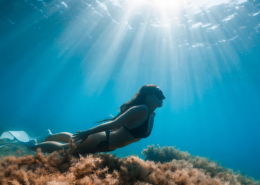


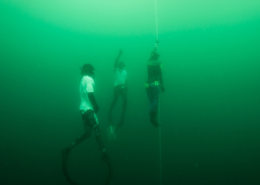

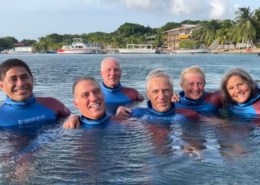
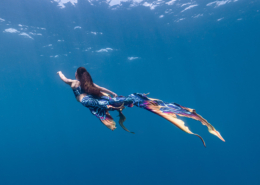
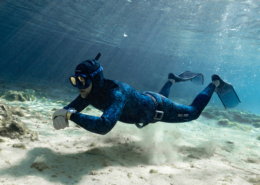
Hinterlasse einen Kommentar
An der Diskussion beteiligen?Hinterlasse uns deinen Kommentar!